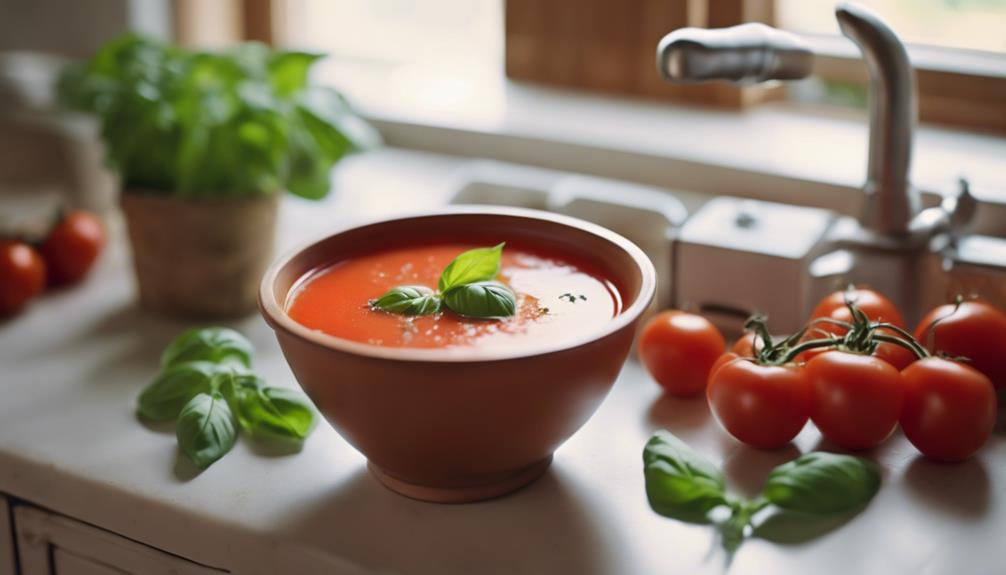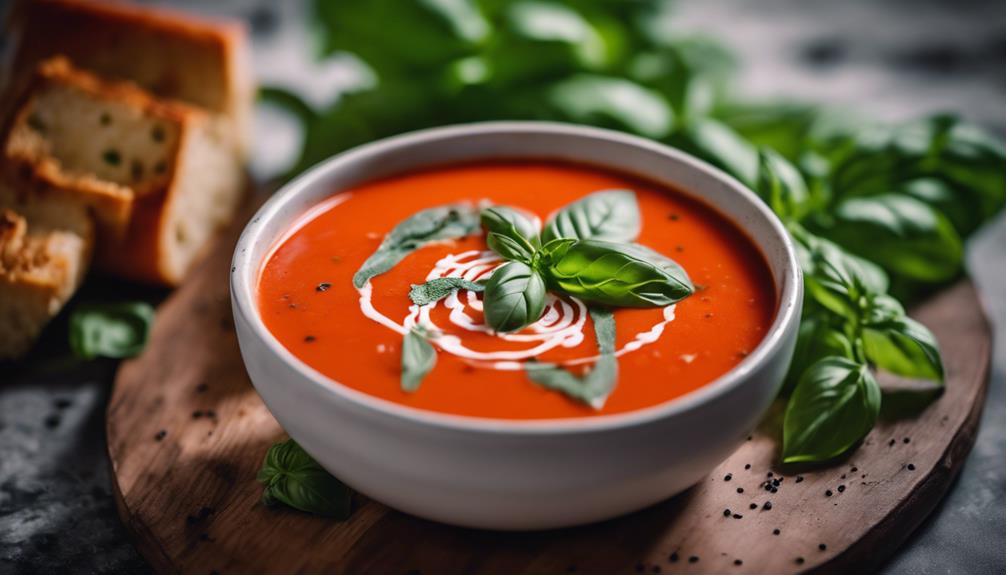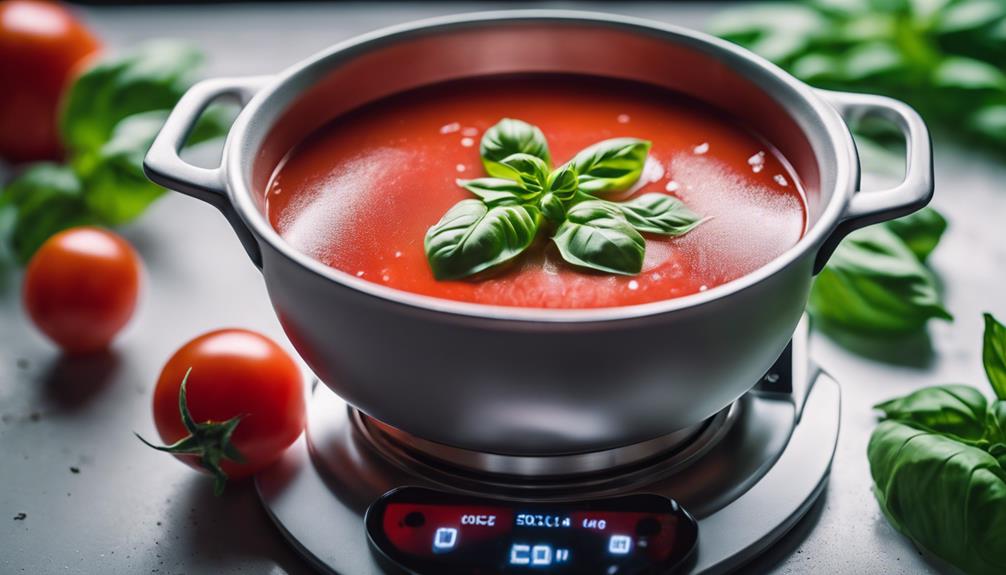Sous Vide Tomato Basil Soup
Immerse yourself in the world of sous vide tomato basil soup, where a fusion of flavors is accompanied by precise cooking control. Start by selecting the perfect tomato variety, such as Roma for a rich base or cherry tomatoes for a burst of freshness. Experiment with different techniques to enhance the soup, such as roasting tomatoes, infusing basil, and incorporating balsamic vinegar. Achieve a harmonious balance of acidity and creaminess by adding Parmesan cheese for an elevated taste experience. To finish, drizzle with top-quality olive oil and season with salt, pepper, and herbs for a gourmet flair. Explore the realm of sous vide cooking to relish this sophisticated take on the traditional tomato basil soup.
What You Will Learn Here
- Sous vide method ensures precise temperature control for perfect soup.
- Infuse flavors by cooking tomatoes and basil together in sealed bags.
- Minimal effort with consistent results for elevated tomato basil soup.
- Experiment with different herb and spice combinations for unique flavors.
- Enjoy rich and flavorful tomato basil soup with sous vide cooking.
Soup's Origin Story

Soup has a rich history that spans centuries, with its origins rooted in various cultures around the world. Understanding the historical significance of soup can provide insight into the evolution of this beloved dish.
From ancient civilizations to modern culinary practices, soup has remained a versatile and comforting meal throughout history.
Soup History Overview
In the culinary world, the origins of soup can be traced back to ancient times when civilizations first combined ingredients in water to create nourishing broths. The evolution of soup has been marked by culinary innovation, with cultures worldwide adding their own unique twists to this comforting dish.
Throughout history, soups have held significant cultural importance, often becoming intertwined with various traditions and ceremonies. From the hearty stews of medieval Europe to the delicate consommés of French cuisine, soup has been a versatile and enduring culinary creation.
As societies developed, so did the art of soup-making, leading to a wide array of recipes and methods that catered to diverse tastes and dietary needs. Whether enjoyed as a simple peasant meal or served in lavish banquets for royalty, soup has remained a staple in kitchens around the globe.
Exploring the rich history of soup reveals not just a dish, but a reflection of human ingenuity and creativity in the world of food preparation.
Origins of Soup
As civilizations began combining ingredients in water to create nourishing broths, the origins of soup took root in ancient times. Culinary traditions and cultural influences played a significant role in shaping the evolution of soup recipes and the development of regional variations. Different regions around the world crafted soups that reflected their unique ingredients and cooking practices, leading to a diverse array of soup styles.
From the hearty stews of Europe to the spicy broths of Asia, soup recipes have been passed down through generations, adapting to local tastes and available resources. The concept of using water as a base for cooking with various ingredients allowed for creativity in preparing nourishing meals that could feed many.
Over time, the art of soup-making expanded beyond mere sustenance, with chefs and home cooks alike experimenting with flavors and textures to create culinary delights. These early soup-making practices laid the foundation for the rich soup culture we enjoy today, where a humble bowl of soup can embody centuries of tradition and innovation.
Historical Soup Roots
Tracing back through the annals of culinary history reveals the intricate tapestry of ingredients and techniques that form the foundation of soup as it's understood today. Soups have a rich history that dates back centuries, with different cultures contributing their unique twists to this versatile dish. The evolution of tomatoes, a staple in many soups, traces back to Mesoamerica, where they were first cultivated and later brought to Europe by Spanish explorers. This tomato evolution greatly influenced culinary trends worldwide, leading to the incorporation of tomatoes into soups like the classic tomato basil soup.
Similarly, basil, with its fragrant and distinct flavor, has a history of cultivation that can be traced to regions like India and other parts of Asia. The culinary uses of basil have been diverse, from medicinal purposes to flavoring dishes like soups, salads, and sauces. When basil is paired with tomatoes in a soup, it creates a harmonious blend of flavors that has stood the test of time. The historical roots of soups like tomato basil soup showcase how ingredients like tomatoes and basil have been integral to the development of soups across various cultures.
Tomato Varieties
Select from a diverse range of tomato varieties to enhance the flavor profile of your Sous Vide Tomato Basil Soup. When it comes to tomatoes, the choices are vast, each offering a unique taste and texture that can elevate your dish to new heights. Consider the following options for your soup:
- Roma Tomatoes: Known for their meaty texture and low seed count, ideal for creating a rich and velvety soup base.
- Heirloom Tomatoes: These varieties, such as Brandywine or Cherokee Purple, bring a burst of complex flavors that can add depth to your soup.
- Cherry Tomatoes: Sweet and juicy, cherry tomatoes can provide a delightful pop of freshness to your soup.
- Beefsteak Tomatoes: With their large size and robust flavor, beefsteak tomatoes are perfect for adding a bold tomato taste to your soup.
- San Marzano Tomatoes: Hailing from Italy, these tomatoes are prized for their sweet flesh and low acidity, making them an excellent choice for a smooth and balanced soup.
Experiment with different tomato varieties to find the perfect combination that suits your taste preferences and enhances the overall dining experience.
Tomato Basil Soup Variations

When it comes to variations of tomato basil soup, you have a few delightful options to explore. Consider trying out a creamy tomato basil bisque for a rich and velvety twist on the classic soup.
Or venture into the domain of creamy tomato basil risotto for a comforting and satisfying meal.
Feeling more adventurous? Whip up a tomato basil pesto pizza for a flavorful and aromatic dish that will surely impress your taste buds.
Creamy Tomato Basil Bisque
To create a rich and velvety Creamy Tomato Basil Bisque, consider blending ripe tomatoes with fresh basil and cream until smooth.
- Use quality ingredients: Opt for ripe, flavorful tomatoes and fresh basil to enhance the bisque's taste.
- Simmer slowly: Allow the bisque to simmer over low heat to meld the flavors and achieve a creamy texture.
- Add a touch of sweetness: A pinch of sugar can balance the acidity of the tomatoes, creating a more harmonious flavor profile.
- Garnish creatively: Sprinkle some freshly chopped basil or a drizzle of cream on top for a visually appealing finish.
- Serve with a side: Pair the bisque with a grilled cheese sandwich or a crusty baguette for a satisfying meal.
Creating a luscious Creamy Tomato Basil Bisque involves simple steps that result in a delightful dish bursting with the flavors of ripe tomatoes and fragrant basil. By following these tips, you can elevate a classic tomato bisque into a creamy delight that will warm your soul.
Creamy Tomato Basil Risotto
For a delightful twist on the classic tomato basil soup, consider trying out a creamy tomato basil risotto that infuses the comforting flavors of tomatoes and basil into a rich and satisfying rice dish. Risotto variations offer a unique way to enjoy the beloved combination of tomatoes and basil in a different culinary form.
When preparing this creamy tomato basil risotto, here are some cooking techniques and tips to enhance your dining experience:
- Use Arborio rice for its creamy texture and ability to absorb flavors well.
- Slowly add warm broth to the rice while stirring continuously to achieve that signature creamy consistency.
- Incorporate diced tomatoes into the risotto for bursts of fresh tomato flavor.
- Season the dish with salt, pepper, and a hint of garlic to elevate the taste profile.
- Finish off the risotto by stirring in freshly chopped basil leaves for a fragrant and herbaceous finish.
Experimenting with risotto variations allows you to explore new ways of savoring the classic tomato basil combination.
Tomato Basil Pesto Pizza
Consider elevating your tomato basil soup experience with a delightful twist – Tomato Basil Pesto Pizza. When you combine the rich flavors of tomato and basil from the soup with the savory goodness of a pizza, you create a mouthwatering dish that's sure to please.
Here are some ways to make your Tomato Basil Pesto Pizza even more delicious:
- Experiment with different pesto variations to add a unique twist to your pizza.
- Get creative with pizza toppings like fresh mozzarella, cherry tomatoes, or roasted garlic to enhance the flavor profile.
- Try adapting your favorite pizza recipe to incorporate the flavors of tomato basil soup for a fusion of tastes.
- Consider adding a drizzle of balsamic glaze or a sprinkle of Parmesan cheese for an extra burst of flavor.
- Don't be afraid to mix and match ingredients to find the perfect combination that suits your taste buds.
Enhancing Tomato Basil Soup Flavor
To enhance the flavor of your tomato basil soup, consider trying different flavor-enhancing techniques like roasting the tomatoes before adding them to the soup, infusing the basil by letting it steep in the broth, or adding a splash of balsamic vinegar for a tangy twist.
Pairing ingredients such as a sprinkle of Parmesan cheese, a dollop of creamy mascarpone, or a drizzle of olive oil can elevate the taste profile of your soup.
Don't forget to season your soup with salt and pepper to taste, and garnish it with fresh basil leaves or a swirl of pesto for a visually appealing and flavorful finish.
Flavor Enhancing Techniques
How can you elevate the flavor of your tomato basil soup to new heights?
To enhance the taste bud satisfaction of your soup, consider using flavor extraction techniques such as slow-roasting the tomatoes before incorporating them into the soup base. This method intensifies the natural sweetness of the tomatoes, resulting in a deeper and more robust flavor profile.
Aromatics infusion is another great way to elevate your soup – try sautéing garlic, onions, and fresh basil in olive oil before adding them to the soup for an extra layer of aromatic complexity.
For an umami enhancement, consider incorporating ingredients like parmesan rinds or a splash of soy sauce to boost the savory notes in your tomato basil soup. These additions can help create a more well-rounded and satisfying flavor experience.
Experimenting with different herbs and spices like oregano, thyme, or a pinch of red pepper flakes can also add a unique twist to your soup, making each spoonful a delightful surprise. By incorporating these flavor-enhancing techniques, you can take your tomato basil soup to the next level of culinary delight.
Ingredient Pairing Tips
Enhance the flavor of your tomato basil soup by carefully pairing complementary ingredients. Understanding flavor profiles is key. Tomatoes offer acidity, while basil brings a fresh, herbaceous note. To enhance these flavors, consider ingredient substitutes like roasted red peppers for sweetness or a splash of balsamic vinegar for depth. These additions can elevate the taste of your soup without overpowering the main ingredients.
When it comes to cooking techniques, consider adding a touch of cream for richness or blending in some Parmesan cheese for a savory boost. These additions can balance the acidity of the tomatoes and add a luxurious texture to your soup.
For serving suggestions, try topping your tomato basil soup with a drizzle of olive oil, a sprinkle of freshly chopped basil, or a dollop of pesto. These final touches not only enhance the visual appeal but also add layers of flavor to each spoonful. By carefully selecting ingredients that complement the tomato and basil base, you can create a soup that's rich, flavorful, and satisfying.
Seasoning and Garnishing
For a burst of flavor and visual appeal, consider seasoning and garnishing your tomato basil soup with a drizzle of high-quality olive oil. This simple addition can elevate the taste profile of your soup, adding a luxurious richness and a hint of fruitiness to complement the tangy tomatoes and aromatic basil.
To further enhance your soup, try experimenting with different garnish ideas such as freshly torn basil leaves, a dollop of creamy crème fraîche, or a sprinkle of crunchy croutons. These garnishes not only add texture but also introduce contrasting flavors that harmonize with the soup's base.
When it comes to seasoning tips, remember that less is often more. Start by seasoning with salt and pepper, tasting as you go to achieve the perfect balance. If you're feeling adventurous, consider incorporating other herbs and spices like a pinch of red pepper flakes for a subtle kick or a dash of smoked paprika for depth.
Final Thoughts

Consider incorporating your favorite herbs or spices to tailor the flavor of the soup to your preference. The sous vide method offers precise temperature control, ensuring that the ingredients are cooked evenly and retain their best taste. This technique is one of the many benefits of sous vide cooking, allowing you to achieve consistent results with minimal effort. By marrying modern culinary techniques with traditional recipes, you can elevate classic dishes like tomato basil soup to new heights of flavor and texture.
When preparing your tomato basil soup using the sous vide method, don't be afraid to experiment with different combinations of herbs and spices. Whether you prefer a more robust basil flavor or want to add a hint of oregano for complexity, the sous vide process will help infuse these flavors into the soup beautifully. Remember to taste and adjust the seasoning as needed to create a soup that suits your palate perfectly.
Frequently Asked Questions
Can I Use Canned Tomatoes Instead of Fresh for This Soup?
Yes, you can use canned tomatoes instead of fresh for this soup. The canned tomatoes will work well in place of fresh ones. They provide convenience and still deliver a delicious flavor when cooked properly.
Is It Possible to Make This Soup Without a Sous Vide Machine?
You can definitely make this soup without a sous vide machine. Consider using a slow cooker as an alternative method or opt for the traditional stovetop approach. Both methods can yield delicious results without the need for specialized equipment.
Can I Freeze Leftover Tomato Basil Soup for Later Consumption?
Yes, you can freeze leftover soup for later. When reheating, use stovetop or microwave. Add a dash of fresh basil for extra flavor. Serve with a sprinkle of Parmesan cheese and crusty bread. Enjoy!
What Other Herbs Can Be Added to Enhance the Flavor?
For enhancing flavor, try experimenting with herb combinations like rosemary-thyme or cilantro-lime. Different herbs can create unique flavor profiles. Have fun with culinary experimentation, taste testing to find the perfect balance for your dish.
How Long Can I Store Tomato Basil Soup in the Refrigerator?
You should store tomato basil soup in the refrigerator for about 3-4 days for best freshness and food safety. Properly sealed containers and quick cooling after meal prep can help extend the shelf life.
Conclusion
To sum up, sous vide tomato basil soup offers a flavorful twist on a classic favorite. By using precise temperature control, this cooking method helps to enhance the natural sweetness of the tomatoes and basil, creating a rich and comforting soup.
Experimenting with different tomato varieties and additional ingredients can elevate the taste profile of this dish even further. Whether enjoyed on its own or paired with a grilled cheese sandwich, this soup is sure to satisfy any craving for a warm and delicious meal.











